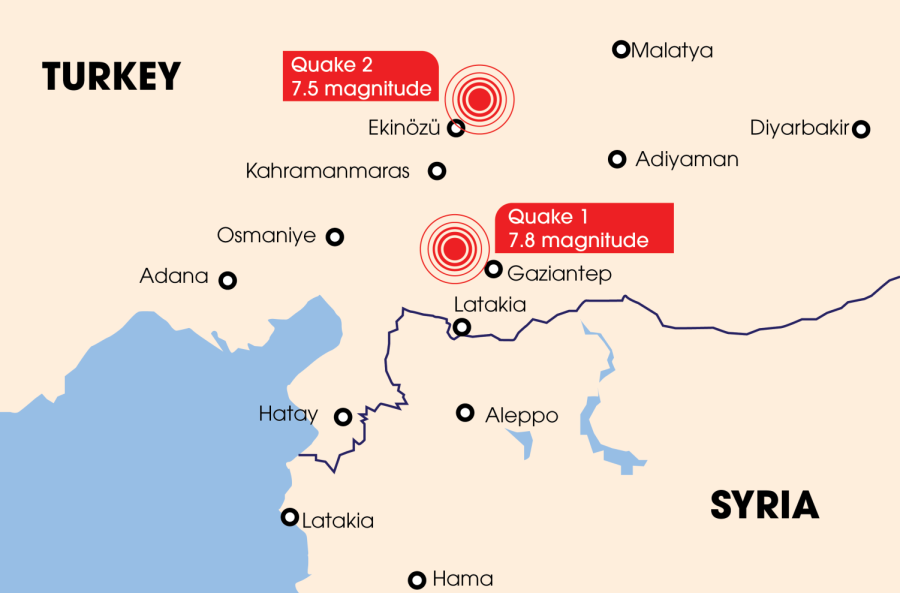Turkey and Syria Left Devastated by Recent Earthquakes
The modern world is no stranger to natural disasters. As technology advances, so does the mitigation of these incidents’ deadly impacts. However, there are times when disaster strikes despite an enhanced understanding of what causes it. This was the case the morning of Feb. 6, as a 7.8 magnitude earthquake shook parts of Turkey and Syria. Nine hours later, a 7.5 magnitude earthquake struck as well. These earthquakes have claimed the lives of over 25,000 people, and as searches for victims buried under the rubble continue, the death toll is expected to increase, with experts projecting it to top 50,000. Amidst these deaths, over 75,000 people have been injured from the quake as well.
The earthquakes hit the Turkish areas of Gaziantep, Kahramanmaras and Antakya. The Syrian areas hit were Sanilurfa and Aleppo. The three Turkish cities are widely known as ancient cities rich with history and were destroyed by the earthquake’s intensity. For the Syrians affected by the quakes, it is one in a series of humanitarian disasters which have rocked the country since the outbreak of war in 2011.
As over 5,700 buildings collapsed in Turkey, many people have gone missing amidst the rubble and debris. The search for survivors continues, and rescues are being made. Workers from around the world, including rescuers from the Seattle area, have been sent to Turkey to provide aid to survivors. Many rescue efforts have been suspended as chances of survival gradually decrease with time. Rescue efforts have also been suspended in rebel-controlled areas in Syria, illustrating the compounding pressures of war and natural disaster upon Syrian society.
The recent earthquakes in Turkey and Syria, now officially known as the “Turkey-Syria earthquakes” came at a time when weather made them particularly deadly. The wet and cold weather across the two nations made accessing affected areas hard for rescue teams. The below-zero temperatures put those trapped under the rubble at risk for hypothermia.
Videos have been posted online showing the conditions of Turkish citizens amidst these earthquakes. Victims have been seen crying out for help as they are trapped under masses of ruin and facing grueling weather conditions, and other videos show the wrath of the earthquakes and their aftermath on the country. Daniela Arrendondo-Sanchez, a first-year nutritional science major at Cornell University, was disturbed by the videos she saw of the disasters.
“Seeing the recordings of people showing what’s happening and the amount of people that have died is tragic. The earthquakes happened around four a.m., and I can’t even imagine being asleep, vulnerable and waking up and not knowing what to do,” Arrendondo-Sanchez wrote to the Spectator.
Experts say recovery could take two to three years in Turkey and up to ten years just for access to rescue work in Syria. Kristiana Thompson, a first-year criminal justice major at Seattle U, expressed concern about how the disaster will affect the survivors.
“Because of these earthquakes, many victims will undergo so much mental and physical trauma from the tragedies they’ve witnessed and the stress of seeing their hometown in ruins,” Thompson said.
Turkey has had a history with earthquakes in past years with the most recent on Nov. 23, 2022. However, the Kahramanmaras earthquake that hit this February is the deadliest earthquake Turkey has seen this century. The death toll is expected to surpass that of the 1939 Erzincan earthquake, which claimed the lives of 32,700 people.
Many fundraisers, drives and donations are being conducted by the International Rescue Committee, UNICEF and Save the Children, among other organizations, to aid the victims affected by the earthquake. Murat Turkmen, a Turkish native residing in Germany, listed some ways people could help the victims in Turkey.
“Donate money to organizations. Clothes, food, and other necessities provide great help, but donating money grants access to many different resources that are far more important than general goods. Additionally, use your platform as much as you can. Share fundraisers, make people aware, share the information so we can raise as much money as possible,” Turkmen wrote in an email to the Spectator.
As the earthquakes in Turkey and Syria leave families homeless, hungry and suffering losses, rescue missions are underway to help aid as many people as possible. The accessibility of relief organizations has and will continue to allow everyone to do their part in rebuilding Turkey and Syria after the natural disaster.


